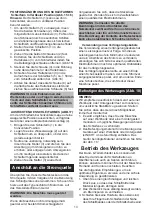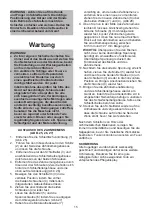
4
5
4
5
connecting to the Power supply
Check that the power supply and plug used is
in accordance with your sander. Have a look at
the rating plate of the motor or the rating on the
sander. Any changes should always be carried
out by a qualified electrician.
If not properly earthed this machine can cause an
electrical shock. Be sure that the power supply
outlet is earthed. If there is any doubt, have it
checked by a qualified electrician.
Using an extension lead
The use of any extension lead will cause some
loss of power. To keep this to a minimum and to
prevent overheating and motor burn-out, seek
advice from a qualified electrician to determine
the minimum wire size of the extension lead.
The extension lead should be equipped with an
earthed type plug that fits the power supply outlet
at one end, and with an earthed type socket that
fits the plug of this machine at the other end.
note:
We highly recommend that you bolt this sander
securely to a work bench to gain the maximum
stability of your machine. Ensure that the machine
is always fixed to a bench whenever possible.
1. It is recommended that you mount your
sander to a workbench or stand in order to
avoid any movement of the sander during
operation.
2. The hardware to mount this sander is NOT
supplied with the sander. The hardware as
shown in Fig. 18 should be used.
warning: this machine must be earthed.
warning: avoid contact with the terminals
on the plug when installing (removing)
the plug to (from) the power supply outlet.
contact will cause a severe electrical shock.
Mounting the tool (fig. 18)
operating the tool
The belt and disc sander is designed to perform
sanding operations on surface, also edge grain.
The sander will also perform freehand forming
and contouring operations. The following
suggestions are recommended for best results
and safest use.
1. Always apply light pressure allowing the
abrasive to remove the material slowly.
2. The workpiece should be moved,
continuously, to avoid burning.
3. Avoid sanding small pieces of wood which will
position the fingers close to the abrasive belt
or disc.
“on/off” switch (fig. 19)
The
i - o
push switch (1) is located on the side of
the sander. Press
i
to turn the tool
on
, and press
o
to turn it
off
.
Mitre gaUge (fig. 20)
A mitre gauge (1) is supplied with your sander
and is used with the disc table. The mitre gauge
body can be adjusted from 0° to 45° right or left
for angle or mitre sanding.
1. Install the slide rod into the table slot (2) as
shown.
2. Loosen lock knob (3) and then rotate mitre
gauge body to the desired angle.
3. Tighten lock knob (3).
Using belt backstoP with sanDing
table (fig. 21)
When using the sanding table in the horizontal
position, to perform surface or edge sanding, the
belt backstop (1) must always be used. Always
hold the workpiece (2) firmly keeping your
fingers always from the sanding belt (3). Always
keep the end of the workpiece against the belt
backstop (1) and move the work evenly across
the sanding belt. Apply only enough pressure to
allow the sanding belt to remove material. Use
extra caution when sanding very thin pieces.
warning: to avoid injury, always keep the
plug disconnected from the power source
and switch turned off until the sander is
completely assembled and adjusted properly.
warning: the bottom edge of the backstop
must be positioned a maximum of 1.59 mm
from the sanding belt to avoid trapping the
workpiece or fingers between the backstop
and sanding belt.
Содержание ENERGYSand-100
Страница 8: ...8 8 ...
Страница 24: ...24 24 Sommaire GB P 1 7 D P 9 15 F P 17 23 The original instruction manual is in English ...
Страница 29: ...29 29 Fig 27 Fig 25 Fig 26 4 3 9 4 8 7 6 5 2 3 1 2 1 Fig 28 Fig 29 ...
Страница 30: ...GB Combiné ponceur bandes et disque ENERGYSand 100 MANUEL D UTILISATION ...
Страница 33: ...33 33 Schematic MODEL ENERGYSand 100 ...






































